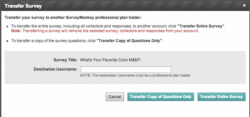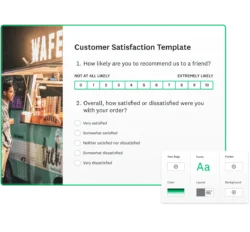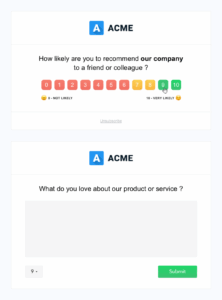Understanding what your customers truly think and feel is paramount for any business aiming for sustainable growth. One of the most effective ways to gauge customer loyalty and satisfaction is through the Net Promoter Score (NPS). An NPS survey is simple, yet incredibly powerful, providing a clear indicator of how likely your customers are to recommend your products or services to others. When it comes to deploying these crucial surveys with ease and efficiency, platforms like SurveyMonkey stand out as a go-to solution for countless organizations.
Leveraging a reliable platform simplifies the entire process, from designing your survey to collecting and analyzing responses. SurveyMonkey, with its user-friendly interface and robust features, makes it incredibly straightforward to implement an NPS strategy. It removes the technical hurdles, allowing you to focus on what truly matters: understanding your customer base and taking actionable steps based on their feedback to foster stronger relationships and drive brand advocacy.
Understanding and Utilizing an NPS Survey Template with SurveyMonkey
The Net Promoter Score (NPS) is a widely recognized metric for measuring customer loyalty. It boils down to a single question: “On a scale of 0 to 10, how likely are you to recommend [Your Company/Product/Service] to a friend or colleague?” Based on their answer, customers are categorized as Promoters (9-10), Passives (7-8), or Detractors (0-6). The beauty of NPS lies in its simplicity and its ability to provide a clear, actionable benchmark for customer sentiment. Regular tracking of your NPS allows you to monitor changes over time, identify trends, and understand the impact of your business decisions on customer loyalty.
While the core NPS question is simple, designing an effective survey that collects valuable insights beyond just the score requires thoughtful consideration. This is where an NPS survey template becomes invaluable. A well-designed template ensures consistency in your data collection, provides a professional appearance, and saves you significant time and effort. Instead of building a survey from scratch every time, you can rely on a pre-structured framework that already includes best practices for NPS measurement and follow-up questions.
SurveyMonkey offers a fantastic ecosystem for deploying these templates. Its intuitive drag-and-drop interface allows even non-technical users to quickly customize surveys. Beyond just the template, SurveyMonkey provides robust analytics tools that help you slice and dice your data, identify key drivers of satisfaction or dissatisfaction, and visualize your NPS over time. This integrated approach means you’re not just sending out surveys; you’re gaining deep, actionable insights that can directly impact your business strategy.
When looking for an nps survey template survey monkey, you’ll find options that can be tailored to fit various industries and specific business needs. The key is to start with a solid foundation and then personalize it to reflect your brand voice and gather the most relevant information from your audience. This combination of a reliable template and a powerful platform sets you up for success in your customer loyalty initiatives.
Key Elements of an Effective NPS Survey Template on SurveyMonkey
- The core NPS question: This is the fundamental question that categorizes your respondents.
- Follow-up open-ended question: Essential for understanding the “why” behind the score, allowing customers to elaborate on their experience.
- Demographic or segmenting questions (optional): These can help you identify if certain customer segments have different loyalty levels.
- Branding options: Customizing the survey with your logo, colors, and fonts to maintain brand consistency.
- “Thank You” page: A polite closing that reassures the customer their feedback is valued.
Crafting and Optimizing Your NPS Survey with SurveyMonkey’s Features
Creating your NPS survey with SurveyMonkey is a straightforward process, thanks to its extensive library of pre-built templates. You can easily navigate to their template section and search for “NPS” or “Net Promoter Score” to find a suitable starting point. Once you select an nps survey template survey monkey provides, you’ll enter the design interface, where the real magic of customization begins. This initial template acts as a springboard, saving you the hassle of setting up the basic question and scoring logic.
Customizing your chosen template is crucial for maximizing its effectiveness. While the core NPS question remains standard, you can add additional questions to gather more nuanced feedback. Consider adding a follow-up question asking “What was the primary reason for your score?” or “How could we improve your experience?” You might also include questions about specific product features, service interactions, or recent experiences. Remember to keep the survey concise to avoid respondent fatigue, as longer surveys often lead to lower completion rates.
Once your survey is designed, SurveyMonkey offers multiple ways to distribute it to your audience. You can generate a simple web link to share on your website, social media, or in email campaigns. For more targeted outreach, you can use SurveyMonkey’s email collector to send personalized invitations directly from the platform, tracking who has opened and completed the survey. Integrating the survey directly into your app or website is another powerful option, allowing you to capture feedback at specific touchpoints in the customer journey.
After your survey is live and responses start rolling in, the real value of SurveyMonkey’s platform shines through its robust analysis tools. You can view your overall NPS score, segment responses by promoter, passive, and detractor categories, and even apply filters based on any additional questions you included. Look for common themes in open-ended responses – these qualitative insights are often just as valuable as the quantitative score, guiding your efforts to improve. Regularly reviewing these analytics allows you to pinpoint areas for improvement and celebrate successes in customer loyalty.
The final, and perhaps most critical, step is acting on the feedback. An NPS survey is not just about measuring; it’s about improving. For Promoters, consider follow-up campaigns to encourage reviews or referrals. For Passives, identify specific areas for improvement to nudge them towards becoming Promoters. And for Detractors, immediate follow-up is essential to address their concerns, mitigate churn, and potentially convert a negative experience into a positive one. This continuous loop of feedback, analysis, and action is what truly drives customer satisfaction and business growth.
Ultimately, leveraging a well-designed template within a powerful platform like SurveyMonkey streamlines your approach to understanding customer loyalty. It provides the tools necessary to not only ask the right questions but also to collect, analyze, and act upon the invaluable feedback your customers provide. By consistently measuring and improving your Net Promoter Score, you build a stronger customer base and foster long-term success for your business.
Embracing this systematic approach to customer feedback can transform how you perceive and interact with your audience. It empowers you to make data-driven decisions that enhance customer experience, cultivate brand advocates, and ultimately contribute to a thriving and sustainable business. The insights gained from a carefully implemented NPS strategy are a priceless asset for any organization committed to placing its customers at the heart of its operations.



